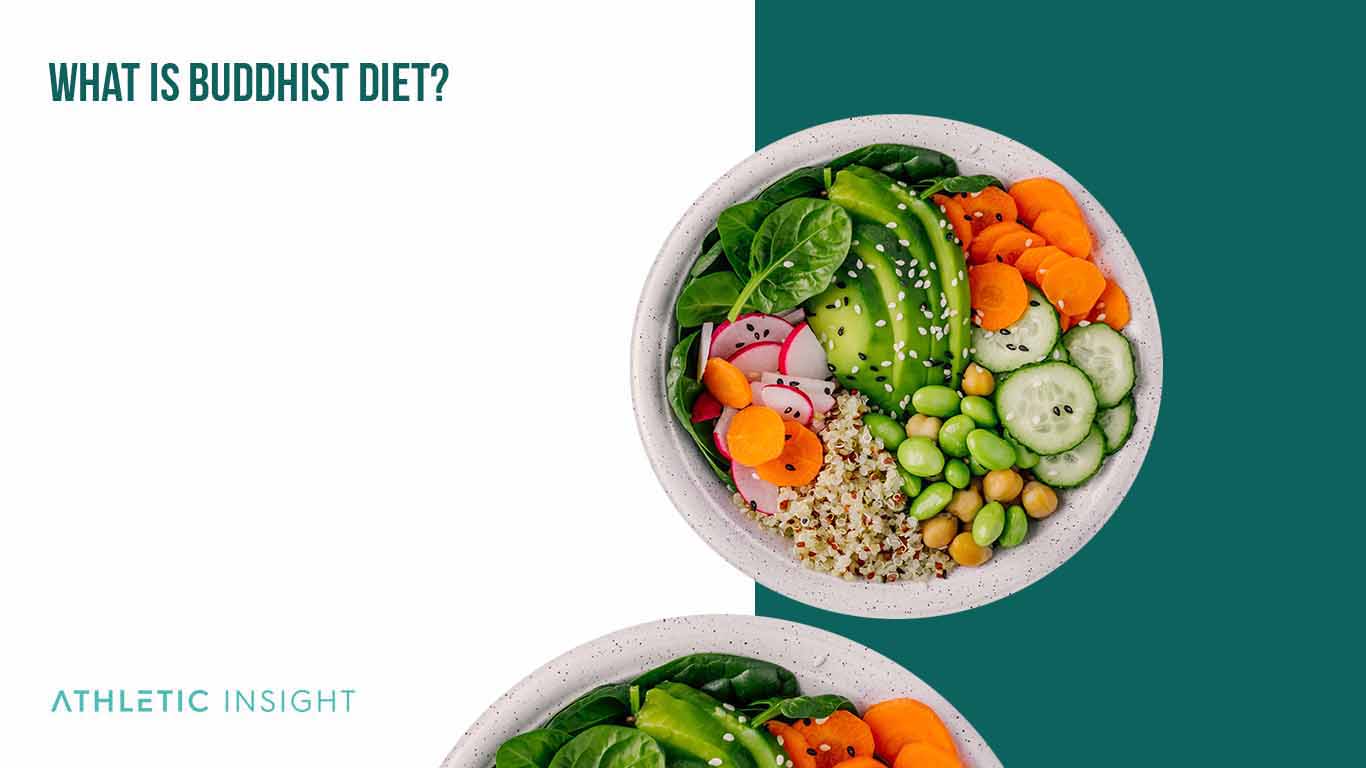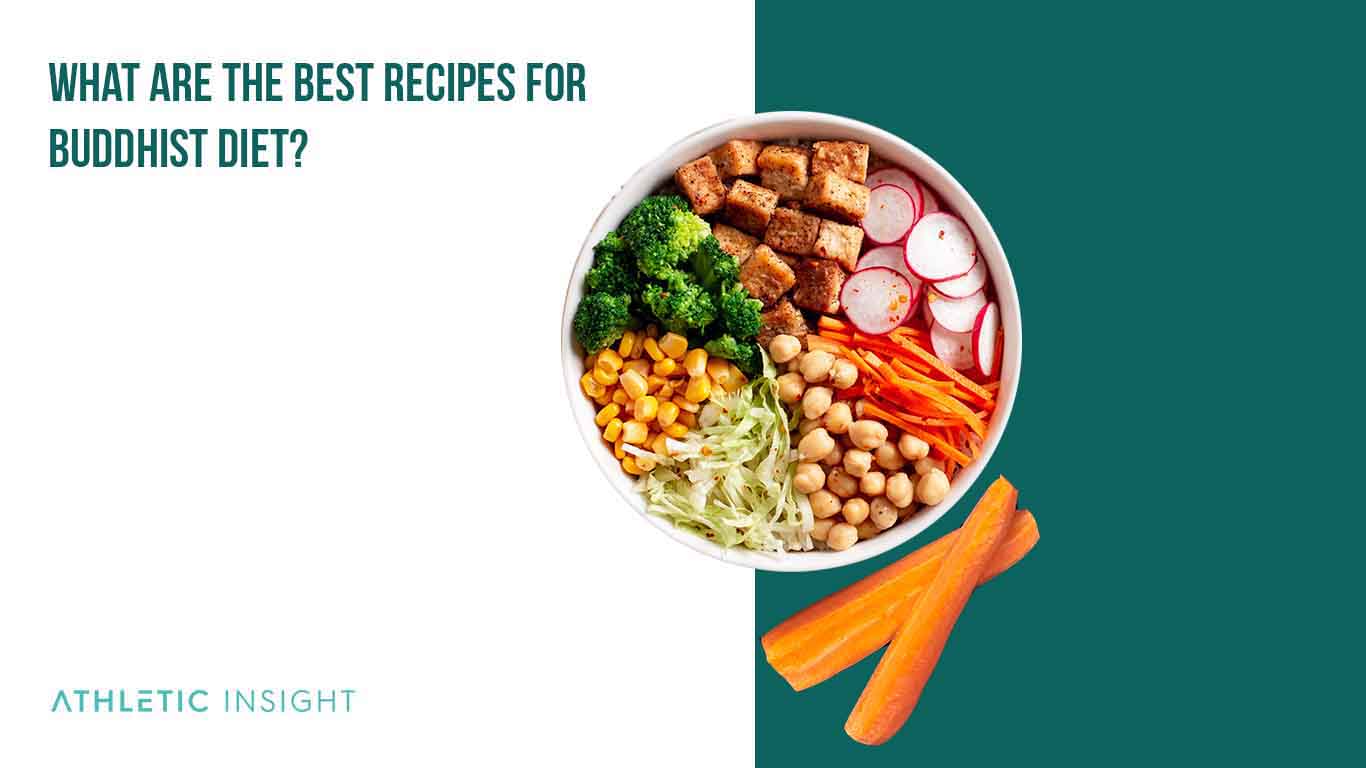The Buddhist diet is primarily plant-based, emphasizing vegetarianism, abstinence from alcohol, and fasting. Variations allow for some meat, alcohol, and other animal products. Benefits to this diet include cardiac, metabolic, and overall physical health because the foods are rich in antioxidants, minerals, fiber, and vitamins.
The Buddhist diet’s importance lies in its connection to Buddhism’s ethical teachings, including gratitude for the nourishment the earth provides. The three most popular Buddhist diets coincide with the three primary Buddhist sects Mahayana, Theravada, and Vajrayana. The Mahayana diet is the strictest interpretation and emphasizes vegetarianism and partial veganism.
The Theravada diet allows for meat, dairy, and other animal products, and the Vajrayana diet grants meat and alcohol consumption. Remember that you do not have to practice Buddhism to reap the benefits of a Buddhist diet plan and can include or eliminate food groups at your discretion.
Here is a breakdown of each variation of the Buddhist diet, its guidelines, physiological advantages and risks, coordinating recipes, and the answers to some of the most common questions about following a Buddhist diet.
What Is the Buddhist Diet?
Buddhist teachings present dietary guidelines in alignment with different spiritual philosophies belonging to the religion. For example, one traditional Buddhist sutra states that followers should not take the life of any sentient being. Many Buddhists interpret this teaching as requiring vegetarianism.

Similarly, Buddhism suggests abstaining from alcohol and drugs to maintain high levels of mindfulness and intention. Some sects prohibit piquant vegetables like garlic and onions because they arouse the senses. The diet’s specifics relate to the Buddhist sect to which an individual belongs.
A common thread among the varying diets is practicing intermittent fasting. In the Buddhist faith, fasting is a method of detoxifying the body and fortifying the mind. The Buddhist diet plan features time restrictions on food intake, promoting mindfulness surrounding food and weight loss.
A Buddhist diet meal plan typically consists of leafy and starchy greens, whole grains, lentils, nuts, seeds, and fruits. Less restrictive versions contain dairy, eggs, meat, and occasional alcohol consumption.
What Are the Rules in the Buddhist Diet?
No Buddhist teaching explicitly prohibits meat, dairy, or alcoholic products because Buddhism is a free practice at its core, leaving the individual to decide how they want to express their faith.
A traditional Buddhist monk diet presents the most strict set of dietary rules. For the Mayahana interpretation of Buddhism, monks abstain from meat and any food that has come into contact with meat products during preparation to practice rigid adherence to Buddhism’s “do no harm” philosophy.
Monks of the Theravada and Vajrayana Buddhist faiths accept meat offerings as a form of gratitude under the condition that the animal was not killed specifically for them.
For those who are not monks wishing to partake in the Buddhist diet, here is a list of general guidelines instead of steadfast rules.
- Maintain primarily plant-based meals
- Avoid vegetables with strong flavors or scents
- Limit or eliminate alcohol intake
- Restrict calorie intake starting at 13 hours before progressing gradually to 9 hours daily
What Are the Health Benefits of the Buddhist Diet?
Following a Buddhist diet offers significant health benefits. The high intake of ingredients containing vitamins, minerals, antioxidants, and fiber lowers the risk of chronic conditions like diabetes, cardiovascular disease, and certain cancers.

The Buddhist diet aids in weight loss through intermittent fasting and prioritizing plant-based recipes. It also presents a unique opportunity to foster mindfulness around your relationship with food by taking a meditative, intentional approach to meal times.
Here is a quick breakdown of the Buddhist diet’s top health benefits.
- Minimizes risk of developing serious conditions
- Enhances metabolic health for potential weight loss
- Builds a positive mental association with food
What are the Health Risks of the Buddhist Diet?
The Buddhist diet also poses potential downsides, including nutrient, protein, or vitamin deficiency such as iron, omega-3 fatty acids, vitamin D, vitamin B-12, and Zinc. You can take dietary supplements or add certain meat or dairy products to the Buddhist diet plan to combat these potential deficiencies.
Intermittent fasting, while it can positively impact blood sugar regulation, body fat, and brain and gut health, also carries risks and is not for everyone. Here are some of the potential cons of intermittent fasting.
- Hunger
- Headaches
- Fatigue
- Dehydration
- Mood swings
- Difficulty sleeping
How To Do the Buddhist Diet?
To adhere to the Buddhist diet, you must adjust your meals and routine. Here is a breakdown of modifications to get you on the right track.
- Set a daily schedule based on fasting windows. Limit your food intake within a 13-hour window for the first two weeks of the diet. Gradually alter the window from there to 12 hours, then 11, 10, and eventually reach the ideal 9 hours daily.
- Prioritize plant-based meals containing primarily vegetables, legumes, lentils, seeds, and nuts.
- Switch out processed snacks for fruits or calming teas between meals.
- Align your mentality with the philosophies that inspire the Buddhist diet by expressing gratitude for the nourishment each meal provides and praising yourself for being intentional with your eating habits.
The Buddhist diet is a low-calorie plan that does not exceed 1000 calories daily. The elements of fasting and strict restrictions might not be sustainable for everyone long-term, but the diet was originally intended to be a lifelong practice.
Adhering to a Buddhist diet variation aids in short-term weight loss, and many people decide to readjust to a different long-term routine after meeting their initial goals on this diet. Others adopt the Buddhist diet as their life-long plan and experience ongoing physical and psychological health benefits.
You can also choose to integrate elements of the Buddhist diet into everyday habits, like practicing a form of meditation or mindfulness surrounding your food consumption even if you don’t stick to the fasting windows or primarily plant-based recipes.
The best ways to practice a Buddhist diet are to focus on mainly bland, vegetarian dishes, limit or eliminate drug and alcohol consumption, and maintain intention around your eating habits to achieve the self-discipline and compassion Buddhist teachings emphasize.
What Are the Foods That You Can Eat While on a Buddhist Diet?
The Buddhist diet prioritizes vegetables, fruits, lentils, whole grains, nuts, and seeds. Here are food examples to include in a strict Buddhist diet.
- Leafy greens: spinach, kale, romaine lettuce, collard greens, bok choy, and swiss chard
- Starchy vegetables: sweet potatoes, corn, carrots, pumpkins, potatoes, butternut squash, plantains, green peas, and acorn squash
- Cruciferous vegetables: cabbage, cauliflower, broccoli, radishes, brussel sprouts, tomatoes, zucchini, cucumber, asparagus, and peppers
- Whole grains: whole wheat bread, brown rice, quinoa, whole wheat pasta, oatmeal, and barley
- Legumes and lentils: chickpeas, black beans, alfalfa, kidney beans, green beans, soybeans, navy beans, red lentils, brown lentils, and black lentils
- Fruits: grapefruit, apples, berries, apricots, cherries, peaches, plums, kiwis, pears, nectarines, watermelon, bananas, oranges, and grapes
- Seeds and Nuts: almonds, cashews, sesame seeds, chia seeds, hazelnuts, sunflower seeds, pistachios, pecans, hemp seeds, walnuts, and pumpkin seeds
- Protein alternatives: soy milk, tofu, seitan, and tempeh
If you are looking for a less restrictive Buddhist diet plan, here are some additional items to include:
- Dairy: Milk, yogurt, and cottage cheese
- Meat and poultry: Pork, chicken, and eggs
- Fish: salmon, tilapia, cod, tuna, herring, and trout
What Are the Foods That You Should Avoid While on a Buddhist Diet?
It’s important to reiterate that different sects call for varying dietary restrictions and that the Buddhist faith does not explicitly prohibit consuming meat, alcohol, or dairy products. That being said, here are examples of what stricter and healthier Buddhist diets recommend avoiding.
- Drugs and alcohol: beer, wine, spirits, and any substance that clouds the mind or alters your state of consciousness
- Meat and poultry: Beef, lamb, pork, veal, chicken, turkey, duck, pheasant, quail, and eggs
- Fish: cod, tilapia, salmon, herring, trout, and tuna
- Piquant vegetables and spices: garlic, onions, leeks, chives, and scallions
- Oils: olive oil, canola oil, flaxseed oil, and avocado oil
- Processed food: white bread, cookies, cakes, white pasta, ice cream, pastries, fruit juice, french fries, potato chips, processed cheese, sugary drinks, pizza, candy bars, margarine, agave nectar, sweetened coffee drinks, and any form of fast food
Who Should Do a Buddhist Diet?
The Buddhist detox diet is helpful to those with an interest in practicing the Buddhist faith, achieving weight loss, or looking to maintain overall health.
It is also effective for those looking to manage diabetes because of the blood sugar regulation effect or someone with a predisposition to serious conditions like diabetes, cardiovascular disease, or certain cancers who wants to proactively avoid developing those illnesses.
What Are the Best Recipes for the Buddhist Diet?
You can make a wide variety of recipes that fall within the Buddhist food diet using leafy greens, starchy vegetables, cruciferous vegetables, whole grains, legumes, fruits, seeds, and protein alternatives. Here are five delicious recipes you can integrate into a Buddhist diet meal plan.

- Thai Cucumber Salad: This simple salad combines one large chopped cucumber, chopped peanuts, and a few tablespoons of soy sauce, maple syrup, and rice vinegar to create a lush bowl of crunchy and Buddhist-friendly goodness. This salad is perfect for beginner chefs who want an easy and efficient meal.
- Italian Sausage Vegan Macaroni: This warm pasta dish requires four ground vegan sausages, whole grain macaroni noodles, diced tomatoes, dried basil, oregano, salt, and maple syrup. This recipe allows you to enjoy comforting, meaty pasta without sacrificing the vegetarian aspect of the Buddhist diet.
- Chickpea Buddha Bowl: This Buddha bowl is another quick and simple meal. Combine vegan mayonnaise, a can of chickpeas, ground sage, maple syrup, and salt in a large bowl before mashing the mixture with a fork. Pour red wine vinegar over the mash and add a dash of dried oregano, then serve over sliced apples, spinach, and couscous.
- Tofu with Spicy Peanut Sauce: This recipe does not adhere to the bland, unarousing dietary guidelines of stricter Buddhist diets, but it’s a good option for someone less concerned with that element. The dish calls for diced tofu with soy sauce, ketchup, vegetable stock, maple syrup, peanut butter, and Siracha sauce. The result is a spicy, healthy meal that you can serve over brown rice or leafy greens.
- Zucchini Muffins with Pumpkin Seeds: Here is a dessert recipe that also makes for a sweet breakfast or healthy treat between meals. Create a mixture of almond flour, brown sugar, applesauce, lemon juice, salt, baking soda, and your choice of plant-based milk. Grate two cups of zucchini to fold into the mix before whisking and pouring into muffin cups. Sprinkle with pumpkin seeds and bake for 25 to 30 minutes at 350°F.
What Is a Sample Buddhist Diet Plan?
Here is a weekly sample Buddhist food diet so you can see what it looks like to follow the Buddhist diet plan.
Monday
- Breakfast: Whole grain pancakes with banana slices
- Lunch: Black bean and couscous salad
- Snack: Herbal tea
- Dinner: Sweet potato and beetroot chickpea salad
Tuesday
- Breakfast: Multigrain hot cereal with peach slices
- Lunch: Lemon avocado toast on whole-grain bread
- Snack: One cup of grapes
- Dinner: Tofu fried rice with Siracha
Wednesday
- Breakfast: Peanut butter quinoa with strawberry slices
- Lunch: Grilled eggplant panini on whole-grain bread
- Snack: One cup of cashews
- Dinner: Chard and white bean whole-grain pasta
Thursday
- Breakfast: Whole grain waffles with cream cheese
- Lunch: Lemon garbanzo salad with spinach
- Snack: Herbal tea
- Dinner: Tofu Chow Mein
Friday
- Breakfast: Yogurt parfait with rolled oats and shredded coconut
- Lunch: Vegetable lentil soup
- Snack: One cup of grapes
- Dinner: Smoked tofu and hummus Buddha bowl
Saturday
- Breakfast: Slow-toasted granola with honey and golden raisins
- Lunch: Spicy peanut soup
- Snack: One cup of almonds
- Dinner: Vegetarian chili with sun-dried tomatoes and beans
Sunday
- Breakfast: Whole grain french toast sticks with flaxseed meal
- Lunch: Nectarine arugula salad
- Snack: Herbal tea
- Dinner: Cream of asparagus soup
What Is a Buddhist Diet Plan in India?
The Indian Buddhist diet utilizes elements of Indian cuisine like curry, rice dishes, vegetables, and bread. Here are sample Indian Buddhist dishes.
- Jackfruit curry
- Red coconut curry
- Brown rice stir fry with vegetables
What Is a Buddhist Diet Plan in Nepal?
The Nepali Buddhist diet contains many lentils, peppers, tomatoes, and potatoes. Here are sample Nepali Buddhist dishes.
- Tomato Achar with smoked chutney, roasted tomatoes, and chili peppers
- Green bean and carrot curry
- Lentils with brown rice
What Is a Buddhist Diet Plan in Thailand?
The Thai Buddhist diet features more aromatic and flavorful options than other Buddhist diet plans because of the native cuisine style. Here are sample Thai Buddhist dishes.
- Mango salad with jalapeno peppers
- Peanut cauliflower wings
- Thai pumpkin soup
What Are Facts About the Buddhist Diet?
The Buddhist diet is not yet mainstream. Here are some facts about the diet you might not know.
- Buddhism prohibits eating snake, tiger, elephant, lion, leopard, horse, bear, hyena, dog, and human meat. These meats are forbidden based on the Buddha’s desire to protect his followers because some animals will attack if they smell the flesh of their species on another being.
- The diet suggests avoiding piquant vegetables based on the belief that consuming foods like garlic, onions, and leeks can stir up anger or sexual arousal.
- Practicing meditation or mindfulness while eating is a spiritual practice with health benefits. Focusing on the food ingested promotes healthy digestion.
- The diet warns against alcohol consumption because the religion heavily emphasizes mental clarity, and the Buddha believed that mind-altering substances encouraged followers to break other ethical pillars of the faith.
- The Buddhist diet integrates fasting, which originates from Buddhist monks building will and self-control to more closely reach enlightenment.
The Buddhist diet stems from a spiritual belief system, but health benefits like being naturally low in saturated fat and cholesterol, and emphasizing plant-based ingredients make it a good option for people looking to lose weight or minimize chronic disease risks.
Does a Buddhist Diet Exclude Onions?
No, a Buddhist diet does not exclude onions. A Buddhist monk’s diet traditionally excludes onions on principle, however, most modern adaptations of the diet plan include onions in the recipes.
Does a Buddhist Diet Exclude Garlic?
No, a Buddhist diet does not exclude garlic. Similarly to onions, garlic is an ingredient prevalent in many vegetarian dishes that people use while practicing the Buddhist diet. It is something that monks are encouraged to avoid, but everyday people can decide what they want to include.
Is the Buddhist Diet Considered a Healthy Diet?
Yes, the Buddhist diet is considered a healthy diet. With its heavily plant-based content and avoidance of processed food products, this is a health oriented diet.
Is the Buddhist Diet Vegetarian?
Yes, the Buddhist diet is primarily vegetarian or vegan, but every individual has the freedom to determine if they want to incorporate meat, dairy, seafood, or other animal products.
Is the Buddhist Diet Expensive?
No, the Buddhist diet is not expensive. Research shows that it costs someone $2.00 less daily on average to practice vegetarianism. The Buddhist diet is not expensive, and you can maximize its affordability by buying vegetables that are in season. It can become pricier if you add meat elements to the Buddhist diet plan.



